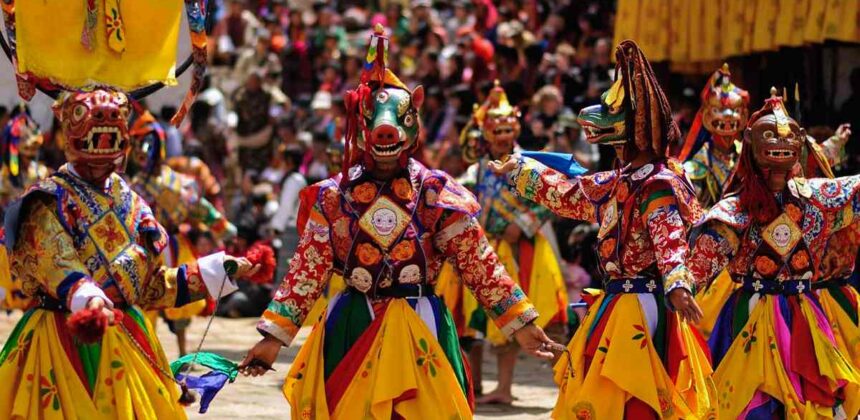Paro Tshechu Festival
Paro Tshechu Festival – Bhutan’s Most Colourful Spiritual Celebration
Bhutan holds a deep spirit in every mountain and valley. People here live close to faith and old traditions. The Paro Tshechu Festival rises from this same soul. It is not just dance and mask—it’s the way people join light and belief. You can feel it when drums echo in the air and monks move like wind over prayer flags. Come to Paro, and also experience the Thimphu Tshechu Festival, where devotion turns into color. Stand quietly when they unfold the great thangka (it shows blessing). This moment teaches you calm and respect without saying a word.
What Is Paro Tshechu – The Meaning Behind Bhutan’s Grand Festival
Paro Tshechu Festival is the most grand Buddhist celebration in Bhutan. It starts every spring, usually March or April, in Paro Dzong (a big fortress with white wall and red roof). Monks wear bright silk robes, people from different valleys come, all want blessing and happiness.
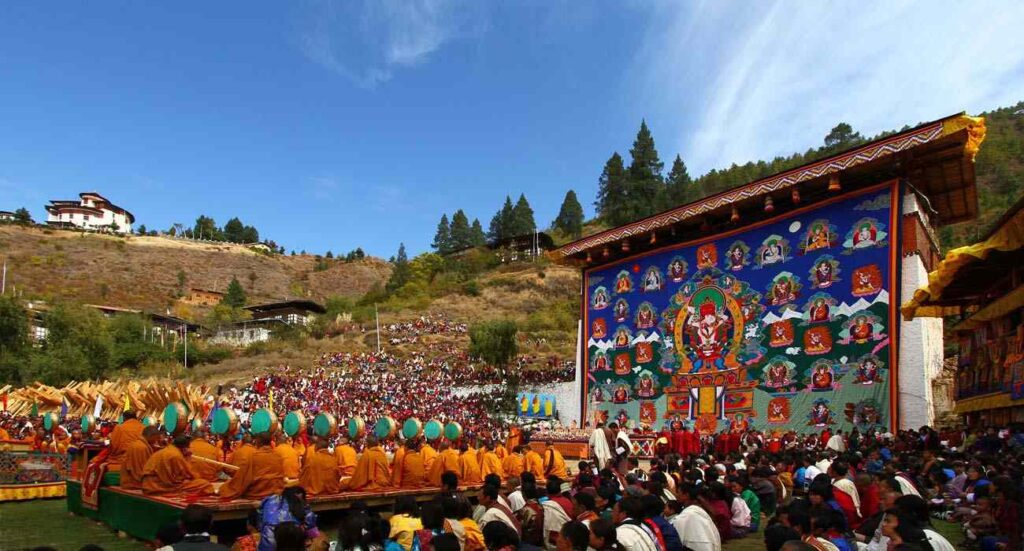
You see big mask dances—these dances are not just entertainment. The monks become different gods, demons, and protectors. Walk slowly, move your hands like swan wings, then stomp hard—this scares away bad luck and brings peace. It feels like watching a live painting, with all the colors moving before you. Young, old, and tourists all take part. Ask yourself—do you want to feel holy power or just enjoy the story? Here, you do both. After the festival, explore the beauty of Sikkim with our Tour Packages for Gangtok for an unforgettable experience.
Paro Tshechu means “festival of tenth day.” The main holy day is display of giant Thongdrol (a sacred cloth scroll), early morning. Stand in line, touch the cloth, pray for all sickness to go away (many believe one look, lifetime blessing). This is real Bhutanese faith and joy. Come respectful, wear good clothes, open mind. This festival is not just history or picture. It is Bhutan’s heart beating in mountain air.
Historical Significance – Honoring Guru Padmasambhava’s Legacy
Paro Tshechu Festival honors Guru Padmasambhava (Guru Rinpoche) who brought Vajrayana to Bhutan in the 8th–9th century, and you should see it as living history, not only a show. It began as tshechu—religious gatherings on the “tenth day”—to recall the Guru’s deeds and teachings, then grew into masked cham dances that retell his eight manifestations like a simple moving textbook for faith.
Start with roots. Guru Rinpoche helped establish Buddhism in the Himalayas, taming local spirits and guiding monastic building at Samye; this legacy flows into Bhutan’s festivals with deep respect and discipline. Then, shift to Paro’s timeline—in the 17th century, Bhutanese rulers linked sacred ritual to state-building at Paro Dzong, fixing tshechu as an annual memory practice (like stitching a flag to a mast). To explore this rich heritage in person, plan your trip with Bhutan Holiday Packages for a truly spiritual journey.
When and Where It Takes Place – The Heart of Paro Valley Comes Alive
The Paro Tshechu Festival happen in Bhutan, a place full of color and old traditions. You should see it if you love dances by monks and big crowds celebrating. It make the valley alive, like a colorful carpet spread over the hills. Now, plan your trip right to enjoy every part.
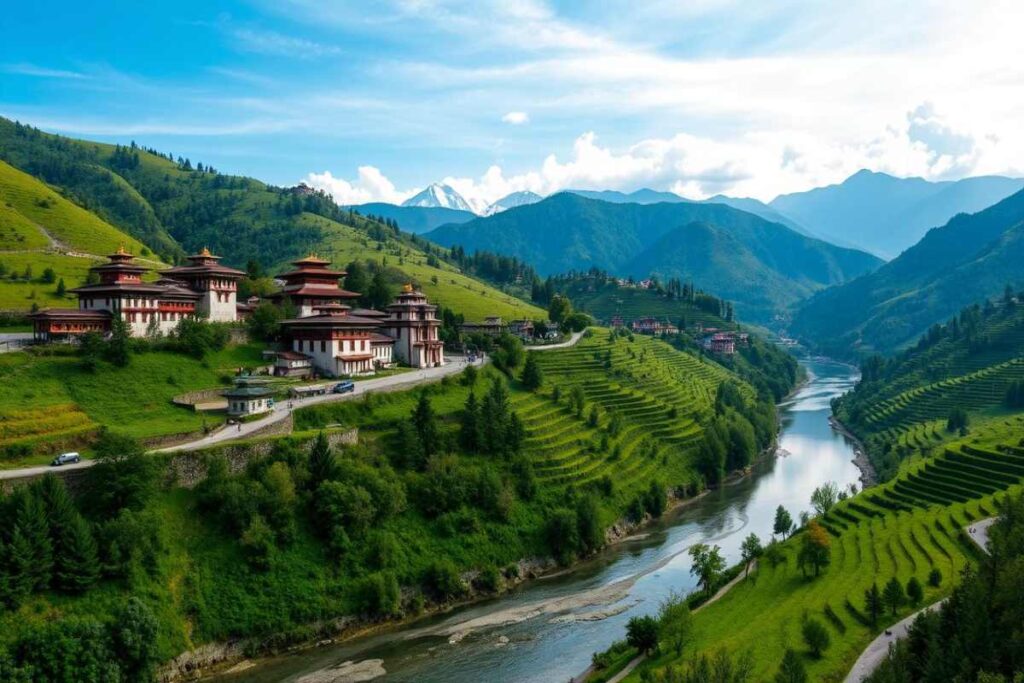
When It Takes Place
- This festival take place every spring, in March or April (follows Bhutan lunar calendar, start on 15th day of second month).
- Last for five days. Main events on third day with masked dances, and final day show Thongdrol, big scroll that bless you just by looking.
- Book early. Crowds come big, hotels go fast in Paro (like marketplace rush).
Where It Takes Place – The Heart of Paro Valley
- Hold at Rinpung Dzong, old fortress above Paro town. Walk up the path, hear horns and drums get louder, feels like stepping back in time.
- Valley around has green fields and mountains. Locals gather here, share food and stories under blue sky.
The Opening Ceremonies – Monks, Chants, and Sacred Rituals
The Paro Tshechu Festival opening ceremonies draw you into Bhutan’s sacred world right away. Monks in colorful masks start with chants that echo like mountain calls. You feel the energy build as rituals honor ancient gods. This is where the valley wakes up with drums and prayers.
Monks’ Arrival
- Monks come from Paro Rinpung Dzong early morning. Wear your best clothes and stand near the courtyard (respect the space).
- They enter with trumpets and cymbals, like a procession of guardians. Watch close; this set the tone for all days.
Chants and Prayers
- Chants rise soft then loud, in old Tibetan words. You should sit quiet and listen; it calm your mind.
- Prayers mix with incense smoke, feels like wrapping in blessings. No photos during this part.
Sacred Rituals
- First ritual show the Black Hat Dance, where monks dance fierce to chase evil spirits away.
- Then they offer butter lamps and tsampa. Join the locals if you can; it make you part of the heart.
Cham Dances – Masked Monks Depicting Good vs Evil
Cham Dances at Paro Tshechu Festival show masked monks fighting good against evil. You’ll see big colorful masks on monks as they dance slow and strong, like giants from old stories. This happens during the festival in Paro Valley, Bhutan. Monks wear heavy costumes while drums beat loud—it teaches you ancient Buddhist tales, so watch closely. After the festival, explore more Bhutan Tourism Places to discover the country’s true cultural and natural beauty.
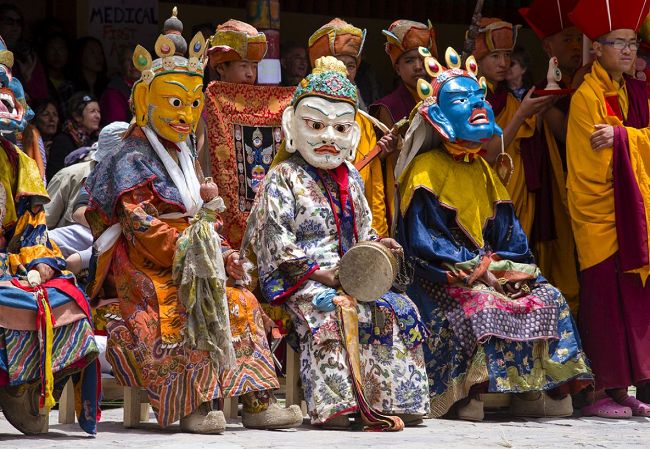
Meaning of Cham Dances
- Cham dances come from Tibetan Buddhism. Monks act out gods and demons to show evil lose to good.
- Each dance has a story, like Black Hat Dance where evil spirits get chased away. You feel the power, as if real battle in front of you.
- Purpose is to teach morals and scare away bad luck for the year (from Bhutan Tourism sources).
How the Dances Performed
- Monks put on huge masks made of wood and paint, some over 3 feet tall. Then they move in circles, stamping feet hard.
- Music from horns and cymbals guide them. Dances last hours, so sit comfortable and stay till end.
- At Paro Tshechu, main dances on second and third day. Bring binoculars if far back (like watching from hill).
What You Should Do
- Arrive early to get good spot near the courtyard. Clap when monks finish a dance, it show respect.
- Talk to locals after, they explain hidden meanings. Do not touch masks or costumes.
The Giant Thangka (Thongdrol) – A Once-a-Year Sacred Unveiling
The Paro Tshechu Festival reaches its peak with the Giant Thangka, or Thongdrol. This sacred unveiling happen only once a year, on the last day. You should wake early to see it. It feels like stepping back in time, with the valley quiet and full of hope.
The Giant Thangka (Thongdrol)
- Thongdrol means “liberation on sight.” It is a huge silk scroll, like a colorful carpet hanging from the dzong wall. Depicts Guru Rinpoche and his forms, so big it covers whole building face.
- Made by skilled monks with gold threads and bright colors. Stored safe all year, then brought out just before dawn. You stand close, and the air gets heavy with chants.
A Once-a-Year Sacred Unveiling
- Happens at 3 AM on final festival day in spring. Monks unfurl it slowly, with prayers loud now. Crowd gathers from night, parents hold kids tight for blessings (like holding an egg, gentle).
- View it quick, before sun touches. They roll it up by 7 AM to keep it pure. This do cleanse your mind, say locals. Go respectful, no photos flash.
Traditional Costumes and Masks – Symbolism in Every Color and Design
The Paro Tshechu Festival showcases traditional costumes and masks that tell deep stories. You see dancers in bright robes and fierce animal heads, each piece full of meaning. It is like a living painting of Bhutan’s old ways. Come prepared to watch closely; these symbols teach about good over evil. This festival happen every spring in Paro Valley, drawing locals and visitors to Rinpung Dzong.
Traditional Costumes
- Wear silk ghos for men and kiras for women; these are the everyday dress but finer for festival (like wrapping yourself in history).
- Colors mean things: red for life force, yellow for earth. You should note how villagers tie their scarves with care.
- Dancers add layers of brocade, heavy and flowing. It make them look strong, like guardians of the valley.
Masks – Symbolism in Every Design
- Masks show gods and demons, carved from wood or leather. Big eyes and horns scare away bad spirits, so they say.
- Atsara masks have funny faces for clowns; they teach morals with jokes. Look for the one like a wise old monkey.
- Each design come from old myths. Red mask mean protection, black for power. Wear your own simple costume if you join the crowd.
Local Participation – How Villagers and Travelers Join the Celebration
The Paro Tshechu Festival draws villagers and travelers together in a big circle of joy. You join in dances and prayers, feel the beat of drums like your own heart. Locals share food, and you learn old stories from them. This make the valley feel like one big family.
Local Participation
- Villagers come early. They wear gho for men, kira for women—bright colors everywhere, like a colorful carpet.
- You should sit on the ground with them. Watch the masked dances, then clap and cheer when it ends.
How Travelers Join the Celebration
- Arrive with respect. Bow to the monks, and follow their lead in circling the thongdrol (it’s like touching luck).
- Eat momos from local stalls. Talk to elders; they tell you why this festival happen every year.
Music, Drums, and Trumpets – The Sound of Spiritual Energy
The Paro Tshechu Festival bursts with sounds that touch your soul. You hear the deep drums and wild trumpets mixing with chants. It is like a wave of spiritual energy rolling through the crowd. This festival happen every year, and the music calls everyone closer to the dances.
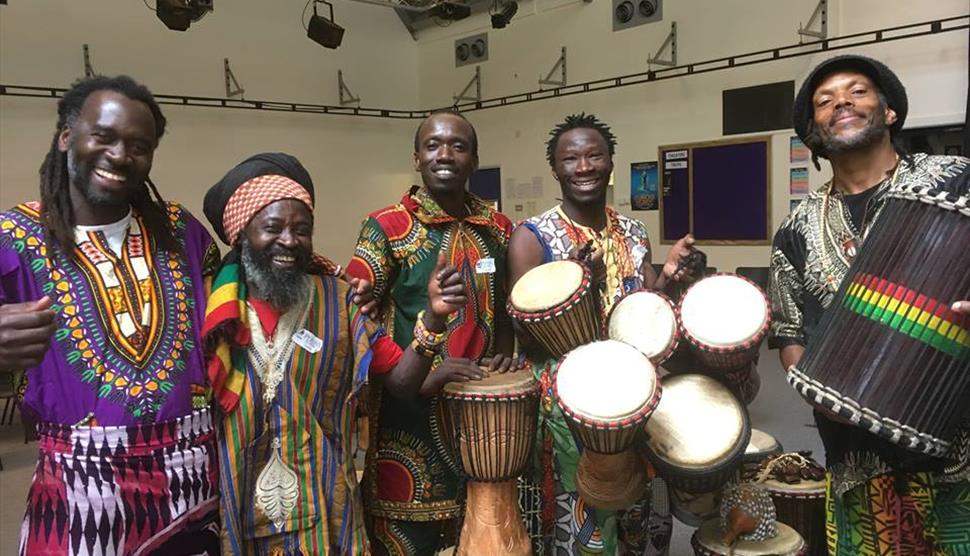
Music
- Start with soft chants from monks. They sing old prayers, low and steady.
- Then horns join in, long and winding like mountain winds.
- You should listen close; it pulls you into the stories of gods and heroes (feels like stepping back in time).
Drums
- Big drums beat strong, like a heartbeat of the valley.
- Smaller ones roll fast during mask dances. They shake the ground under your feet.
- Watch the drummers; their rhythm guide the whole show.
Trumpets
- Trumpets made from shells blow loud blasts. It echo off the hills.
- They signal start of big moments, sharp and holy.
- So, stand ready when you hear them; the energy rise high.
Spiritual Meaning – Cleansing Negativity and Inviting Good Fortune
The Paro Tshechu Festival holds deep spiritual meaning for cleansing negativity and inviting good fortune. You feel it right away when the masked dances start. Monks perform to chase away bad spirits, like sweeping dust from your mind. This happen every spring in Bhutan, and it touch everyone who come.
Spiritual Meaning
- The dances represent gods fighting evil. Watch the Black Hat Dance; it purify your soul (like washing away old worries).
- Thongdrol, the giant scroll, bless you just by looking. It invite prosperity and health into your life.
- Join the crowd. Chant along, and feel negativity lift. Locals say this bring luck for the year ahead.
Cleansing Negativity
- Start with offerings at the dzong. Burn incense to release bad energy.
- Circle the sacred sites. Do it clockwise, as if pulling in light and pushing out darkness.
Inviting Good Fortune
- Receive tika from lamas on the last day. This mark your forehead for blessings.
- Share tsampa with others. It build positive karma, so good things follow you home.
Paro Dzong – The Iconic Fortress That Hosts the Celebration
Paro Tshechu Festival happens at Paro Dzong, the big fortress that watch over the valley. You go there and feel the history, like stepping back in time to old Bhutan. It host the dances and masks, draw crowds every spring. This place is not just stone; it alive with prayers and colors.
Paro Dzong – The Iconic Fortress
- Build in 15th century by Zhabdrung Ngawang Namgyal, it stand tall on a hill (protect the town like a guardian).
- Walls white and gold, with watchtowers that catch the sun. Inside, courtyards big for the festival crowds.
Hosts the Celebration
- During Paro Tshechu Festival, monks perform cham dances here. You sit on the ground and watch, feel the drums shake the air.
- The dzong have murals of gods and stories. Look up at them; they teach about karma.
- Book guide if first time. Paths steep, so wear good shoes.
How to Visit Bhutan and Attend Paro Tshechu 2025 – Entry Permits, Flights, and Travel Guide
The Paro Tshechu Festival calls you to Bhutan next spring, in 2025. It takes place at Rinpung Dzong, filled with masked dances and blessings—like a colorful carpet spread over the valley. You should plan early to join this joy and carry respect for the old ways. To make your trip even better, learn about the Best Season to Travel to Bhutan for a perfect experience.
How to Visit Bhutan
- Fly into Paro Airport only. Direct flights from Delhi or Bangkok, then connect if from elsewhere.
- Get your visa before. Apply online through Bhutan’s tourism site, pay the Sustainable Development Fee (about $100 a day for Indians).
- Travel light. Roads twist like mountain paths, so use buses or taxis from airport to town.
Entry Permits for Paro Tshechu 2025
- Indians need a permit at entry point, like Phuentsholing border or Paro Airport. Show ID and festival dates (March 21-25, 2025, check lunar calendar).
- No visa for Indians, but get entry permit free. It cover your stay, renew if longer (like a simple stamp).
- Source: Bhutan Tourism Council, official guidelines.
Flights and Travel Guide
- Aim for flights in March 2025. Druk Air or Bhutan Airlines, book six months ahead, seats fill fast.
- From India, fly Delhi to Paro, two hours. Then, hike up to dzong for festival view (feels like stepping back in time).
- Stay in guesthouses near Paro. Eat local thukpa, and wear modest clothes for ceremonies.
Tips for Travelers – Best Time to Visit and What to Expect
The Paro Tshechu Festival draw crowds from all over. You should plan your trip now if you love Bhutan culture. It happen in spring, full of dances and blessings.
Best Time to Visit
- Go in March or April, follow the lunar calendar (like the 15th day of second month). Weather nice, not too cold.
- Avoid summer rains; they make paths muddy. Book flights early, hotels fill fast.
- Early morning best for views, as sun rise over valley like golden light.
What to Expect
- See masked dances at Rinpung Dzong, feel the energy like heartbeat of old Bhutan. Crowds big, so wear comfortable shoes (and carry water).
- Food stalls offer spicy momos and tea. Respect locals, don’t push in lines.
Final Reflection – Paro Tshechu as the Soul of Bhutan’s Living Heritage
Paro Tshechu Festival captures the soul of Bhutan’s living heritage. It happens every year in Paro Valley, bringing old dances, songs, and stories to life. You’ll see monks in masks perform like guardians of ancient times, and crowds gather as if for a family reunion. This is not just a show—it teaches respect for traditions that still guide Bhutanese life.
Also, check Bharati Tour on Google My Business for directions, reviews, and updates to plan your Bhutan trip with ease.
- Go to Paro Tshechu to feel Bhutan’s heart beat. You should watch the cham dances closely; they tell tales of gods and demons (like stepping into a living myth).
- It preserve heritage through joy. Locals share momos and tea with you, so join in and learn.
- Take away peace from this. Visit once, and you carry Bhutan’s spirit home forever.
Plan A Vacation With Us
Frequently Asked Questions
This festival happen every spring, in March or April by Bhutanese lunar calendar. It last five days, starting around 10th day of second month. You should check exact dates on official sites before planning. Book early so you don’t miss it.
It take place at Rinpung Dzong in Paro Valley, Bhutan. The dzong sit on a hill, overlooking town and fields like a watchful guardian. You walk up path, and soon music reach your ears.
Watch masked dances by monks, they tell stories of gods and demons. Villagers wear bright robes, and drums beat loud. On last day, see huge Thongdrol scroll – touch it for blessings (if crowd allow). It feel like colorful carpet unfold.
Get visa through tour operator, Bhutan require guided tours. Arrive in Paro by flight, then go to dzong. Carry warm clothes for cool evenings, and respect local customs – no photos inside sacred areas. Join crowd, but stay polite.
Yes, families come with kids. It like a big gathering, with food stalls and fun dances. But it crowded as marketplace, so hold hands with children. This celebration teach about Bhutan culture, good for all ages.
It bring spiritual joy and community spirit alive. You feel connected to ancient ways, like step back in time.

